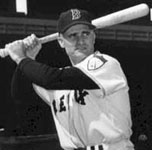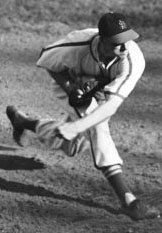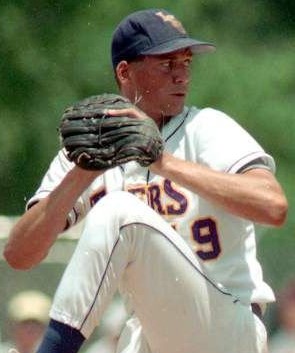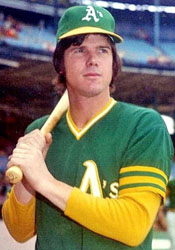|
February 22, 2023
Tom Seaver's Circuitous Road to the Mets
David Schoenfield, espn.com, September 2, 2020
Fifty-one years later, it might still be the greatest baseball story ever told. The Miracle Mets of 1969, never having finished above .500, going from ninth place in 1968 to the World Series title. The hapless, bumbling, laughingstock New York Mets, most famous for the time Marv Throneberry hit an apparent game-winning triple only to have missed first base, with the Mets instead losing the game. Those luckless, atrocious Mets, whom Casey Stengel explained had selected a certain catcher in the expansion draft because they needed somebody to prevent the ball from rolling to the backstop.
That's how the Mets were born and, boy, were they bad. They lost 120 games that first season in 1962 and followed up with seasons of 111, 109 and 112 losses. In 1966, they climbed out of last place for the first time -- all the way up from 10th place to ninth. The fans in Queens loved them nonetheless. Even though the Mets lost 95 games that year, they finished second in the major leagues in attendance.
The transformation from lovable losers to champions began in 1967. It began with Tom Seaver.
 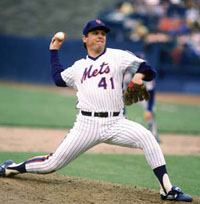  Tom Seaver with USC and the Mets. The story of how Seaver landed with the Mets is a little miracle in itself. The Atlanta Braves had drafted the Southern California right-hander in the secondary phase of the January draft in 1966, a part of the draft that no longer exists and was reserved for players previously drafted who didn't sign. The Los Angeles Dodgers had drafted Seaver in the 10th round in 1965, but a Dodgers scout named Tommy Lasorda refused to meet Seaver's $70,000 asking price. Seaver returned to school.
Seaver and the Braves reached a deal in late February for a $40,000 bonus. USC's spring season had already started, however, and under baseball's rules, a team couldn't sign a player if his college season had begun. Commissioner Spike Eckert nullified the contract. Seaver then tried to return to school, but the NCAA declared him ineligible, even though he had yet to accept any money.
It was a classic Catch-22 situation. Seaver's dad threatened a lawsuit. Eckert, in an unprecedented move, set up a special lottery. Any team willing to match Atlanta's $40,000 bonus could participate, but the Braves were banned from signing Seaver for three years. Only three teams chose to get involved in the Seaver sweepstakes: the Philadelphia Phillies, Cleveland Indians and Mets. The Mets won the lottery.
Eckert explained his decision was "for the interest of the boy and the public. The youngster previously signed a contract with another club in good faith only to learn he had been improperly contracted," Eckert said. "It was not his fault that the contract was invalidated."
Did the Mets know what they were getting? It's perhaps noteworthy that only three teams thought he was worth that $40,000 bonus, though that was a sizable bonus for the time, more than most of the first-round picks would receive that June. Seaver had been lightly scouted in high school in Fresno CA, but he was just 5-foot-9 and 160 pounds as a senior in 1962. He spent the next year working in a packing plant and joined the Marine Corps Reserve. After a year at Fresno City College, he transferred to USC.
So while Seaver was only the 20th pick in the January phase, it was apparent he was an excellent prospect. The Fresno paper called him a "fireballing right-hander." It's possible that Seaver's bonus demands scared some teams away. His dad also thought Seaver's military commitment might have been an issue. "The Braves were the only club to go after him," Charley Seaver said, "possibly because of his military status."
But it's also possible some teams hadn't seen Seaver and that even though he had gone 10-2 with a 2.47 ERA for USC, his fastball didn't impress. Years later, Baseball America quoted a veteran scout from the area who said of Seaver: "Some clubs wouldn't give him more than $4,000 because he had a below-average fastball. But he pitched against a team called the Crosby All-Stars just before the draft and was facing active major leaguers. He struck out 12 in five innings."The Fresno Bee didn't mention that game, but it did mention one outing for USC early in 1966 when Seaver threw five perfect innings against the San Diego Marines. The paper also said the Dodgers had reportedly offered Seaver $50,000 to sign in 1965.
Seaver was an immediate star in New York. He spent 1966 in the minors and reached the Mets in 1967, when he went 16-13 with a 2.76 ERA and won National League Rookie of the Year honors. He went 16-12 with a 2.20 ERA in 1968 as the Mets climbed out of the cellar. Still, after going 73-89, they weren't expected to do much in 1969, the first year the leagues were split into divisions.
All the Mets did in 1969 was win the World Series. Tom Seaver was elected to the Hall of Fame in 1992.
|
